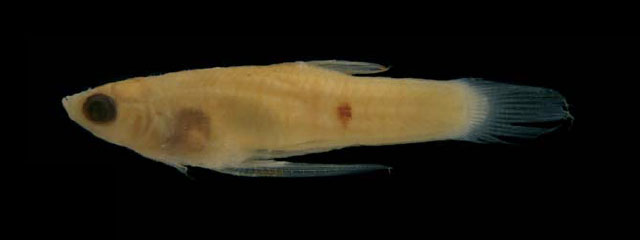| Poeciliidae (Poeciliids), subfamily: Poeciliinae |
| 1.75 cm SL (male/unsexed); 2.47 cm SL (female) |
|
benthopelagic; freshwater |
| South America: Brazil in flooded areas on margins nearby Antonina and rio Dois de Fevereiro, flowing into the Baía de Paranaguá. |
|
Dorsal soft rays (total): 8-8; Anal soft rays: 9-11; Vertebrae: 32-32. Diagnosed from other species of the genus Phalloceros except Phalloceros megapolos, Phalloceros spiloura, Phalloceros malabarbai, Phalloceros anisophallos, Phalloceros buckupi, Phalloceros uai, Phalloceros lucenorum, Phalloceros pellos, and Phalloceros reisi by the female urogenital
papilla curved to the right, located laterally (vs. slightly left turned and with a lateral ramus or straight located along midventral line; and border of the anal aperture in contact with the first anal-fin ray or very close to it (vs. separated from first anal-fin ray by the female urogenital papilla). Differs from Phalloceros megapolos by the gonopodial appendix normally developed (vs. greatly expanded in wing like expansions); and from Phalloceros spiloura, Phalloceros anisophallos, Phalloceros buckupi, Phalloceros uai, Phalloceros lucenorum, Phalloceros pellos, and Phalloceros reisi by the halves of gonopodial paired appendix slender, not sickle like, and similar to each other (vs. sickle like and different from each other), bearing a medial corner (vs. medial corner absent); and hooks on both halves of gonopodial paired appendix (vs. right half hook absent).
Distinguished from Phalloceros malabarbai by gonopodial appendix straight at the distal tip (vs. strongly arched at the distal tip); distal portion straight and oblique forming a 45º angle with the vertical axis (vs. distal portion bent upward); and left and right halves
coalescent at the base (vs. halves free not coalescent at the base) (Ref. 76852).
Description: Pectoral fin with 6-7 branched rays; longitudinal series of scales 28-30; transverse series of scales 7 (Ref. 76852). |
|
|
Least Concern (LC); Date assessed: 07 November 2018 Ref. (130435)
|
| harmless |
Source and more info: www.fishbase.org. For personal, classroom, and other internal use only. Not for publication.

